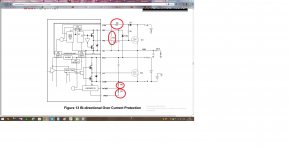Hello, I have two modules of 700W into 4 ohms with irs2092 and irfb23n15d (the other module has the version instead irfb23n20d).
The transformer is a 500VA 55-0 55.
I use to play along with the bass guitar.
Yesterday I tested it at high volumes and I have noticed that, in the most high-volume input (slap) sound for 1 second and then disappeared back.
He went into protection.
How can I do to increase the protection threshold? or just delete it?
Thank you very much.
I trust in you.
The transformer is a 500VA 55-0 55.
I use to play along with the bass guitar.
Yesterday I tested it at high volumes and I have noticed that, in the most high-volume input (slap) sound for 1 second and then disappeared back.
He went into protection.
How can I do to increase the protection threshold? or just delete it?
Thank you very much.
I trust in you.
Today I tried to put a transformer 1000VA and I used the version with irfb23n20d but I realized that cold .... nothing happens after a few minutes it warms up to the peaks resets the amp and then no sound for a split of a second.
I tried to change the resistors R2 and R5 increasing the value ... from 10k to 15 k and 20k to 27k.
Connected everything and you are immediately burned mosfets.
It 'possible that the cause is the resistance?
cm ² the other module has the problem of reset during peak only after 3-4 minutes.
In the first minutes also played at high volume there is no problem.
What can it be? who else can help me?
Connected everything and you are immediately burned mosfets.
It 'possible that the cause is the resistance?
cm ² the other module has the problem of reset during peak only after 3-4 minutes.
In the first minutes also played at high volume there is no problem.
What can it be? who else can help me?
I tried to change the resistors R2 and R5 increasing the value ... from 10k to 15 k and 20k to 27k.
Connected everything and you are immediately burned mosfets.
It 'possible that the cause is the resistance?
cm ² the other module has the problem of reset during peak only after 3-4 minutes.
In the first minutes also played at high volume there is no problem.
What can it be? who else can help me?
Those resistor values are too high.
If I remember correctly they should add up to less than 10K.
Read the app note for more info.
I have just finished a stereo/bridged design and had resetting problems.
Reset is caused by numerous sources.
VAA, VSS, VCC, VB and DC on output. Also basic design flaws will upset the 2092.
Decoupling and short tracks are vital.
On my design I didn't go through the whole pcb and ask if each component was set optimally. My problem was the decoupling wasn't close enough to the mosfets. When I tacked on some more decoupling close to the mosfets the amp stopped resetting.
See pcb layout enclosed. Note fat tracks and close decoupling on the right hand side where the mosfets are.
Reset is caused by numerous sources.
VAA, VSS, VCC, VB and DC on output. Also basic design flaws will upset the 2092.
Decoupling and short tracks are vital.
On my design I didn't go through the whole pcb and ask if each component was set optimally. My problem was the decoupling wasn't close enough to the mosfets. When I tacked on some more decoupling close to the mosfets the amp stopped resetting.
See pcb layout enclosed. Note fat tracks and close decoupling on the right hand side where the mosfets are.
An externally hosted image should be here but it was not working when we last tested it.
An externally hosted image should be here but it was not working when we last tested it.
Last edited:
Its worth checking for bus pumping as class d singled ended doesn't like low frequencies at high voltages.
Look for the power rails going up when you play a note.
Look for the power rails going up when you play a note.
Those snubber caps are still miles away from the MOSFETs. I'm constantly shaking my head at those who insist on designing Class D amplifiers with only through-hole parts. With surface mount caps on the underside of the board, they can almost literally be sitting right on the MOSFET leads and the very short traces will have minimal inductance.
I have just finished a stereo/bridged design and had resetting problems.
Reset is caused by numerous sources.
VAA, VSS, VCC, VB and DC on output. Also basic design flaws will upset the 2092.
Decoupling and short tracks are vital.
On my design I didn't go through the whole pcb and ask if each component was set optimally. My problem was the decoupling wasn't close enough to the mosfets. When I tacked on some more decoupling close to the mosfets the amp stopped resetting.
See pcb layout enclosed. Note fat tracks and close decoupling on the right hand side where the mosfets are.
Those snubber caps are still miles away from the MOSFETs. I'm constantly shaking my head at those who insist on designing Class D amplifiers with only through-hole parts. With surface mount caps on the underside of the board, they can almost literally be sitting right on the MOSFET leads and the very short traces will have minimal inductance.
IR says it is OK to use through hole pcb so long as you use B- and GND powerplanes.
- Status
- Not open for further replies.
- Home
- Amplifiers
- Class D
- problem of overload? IRS2092
